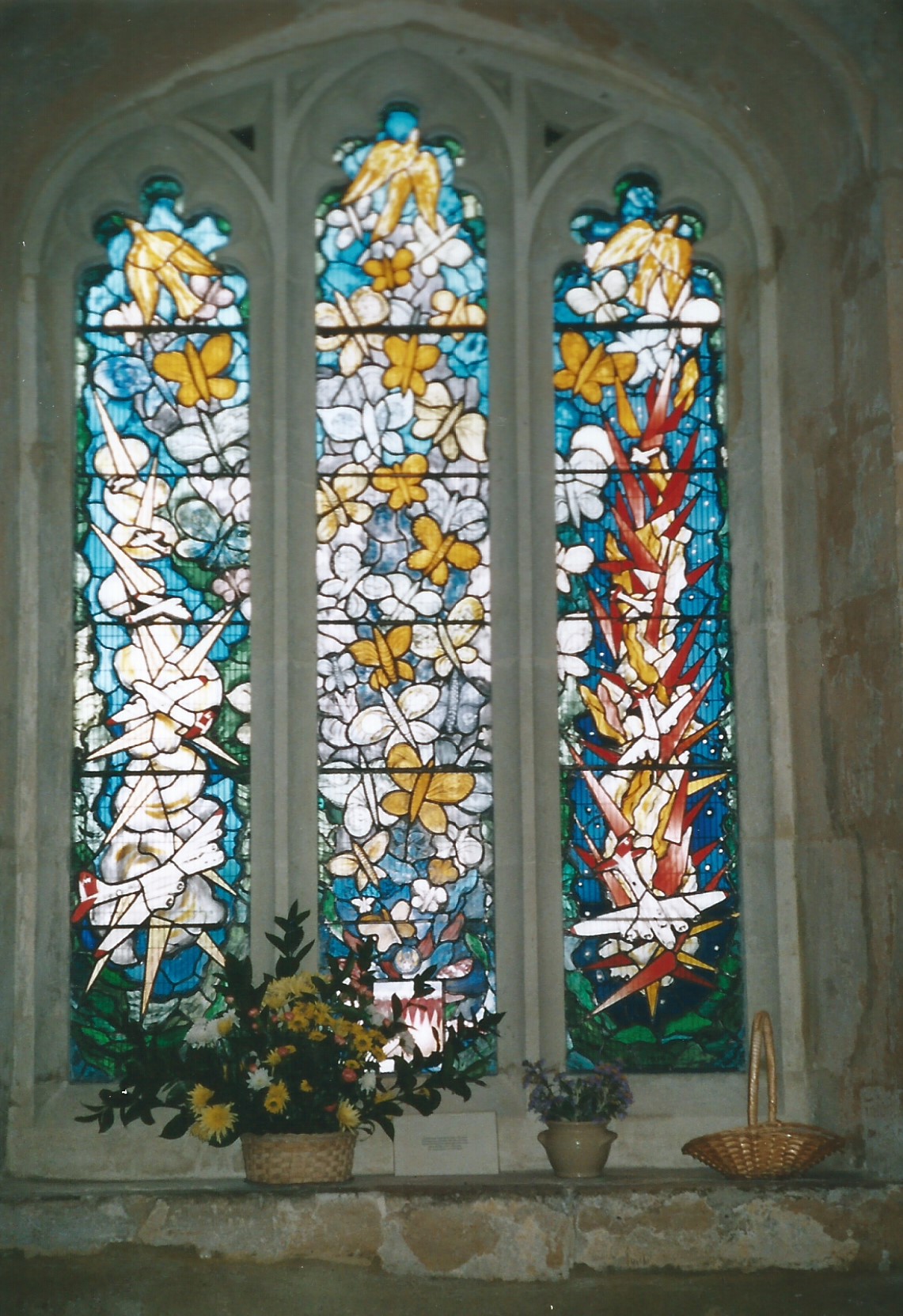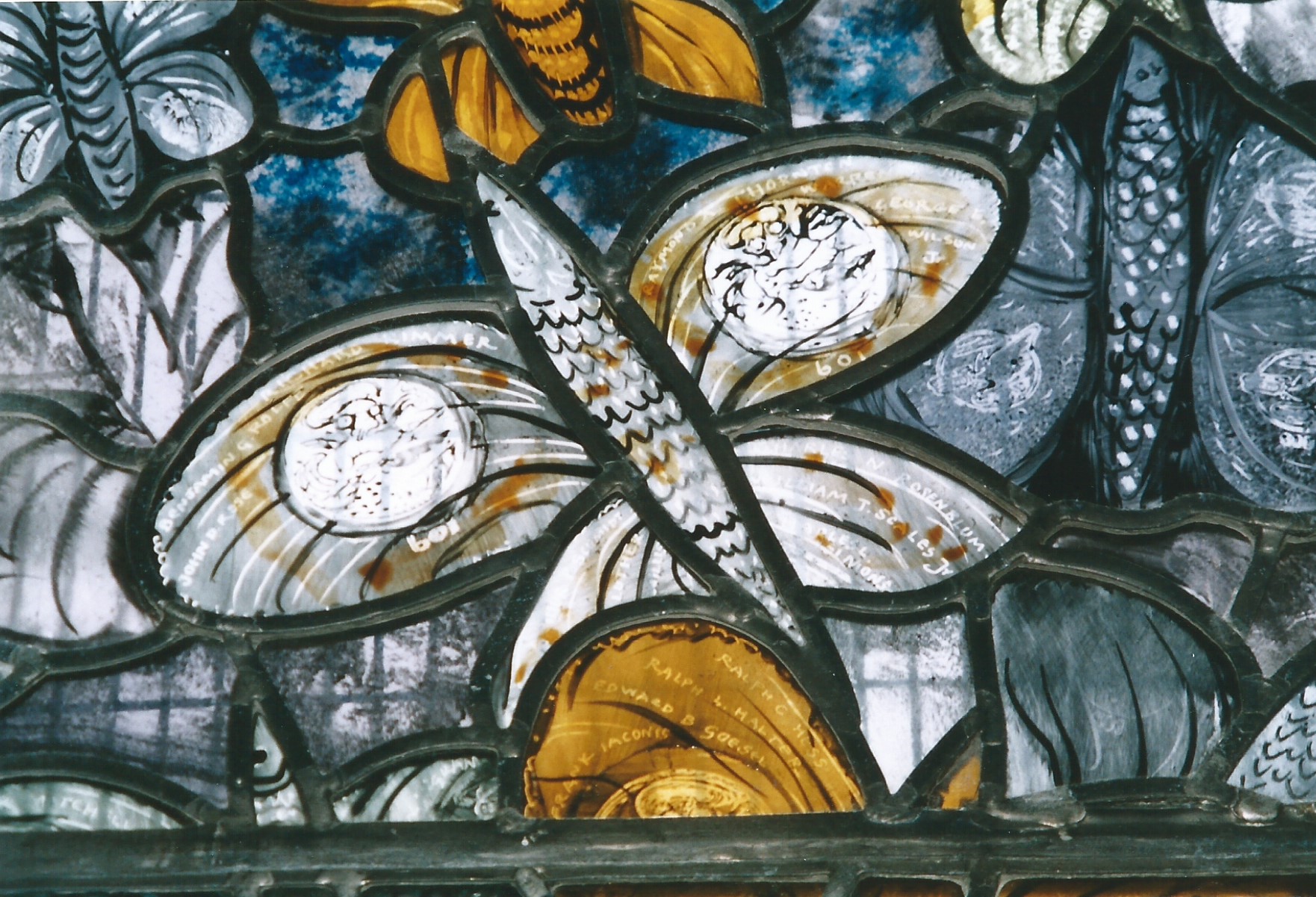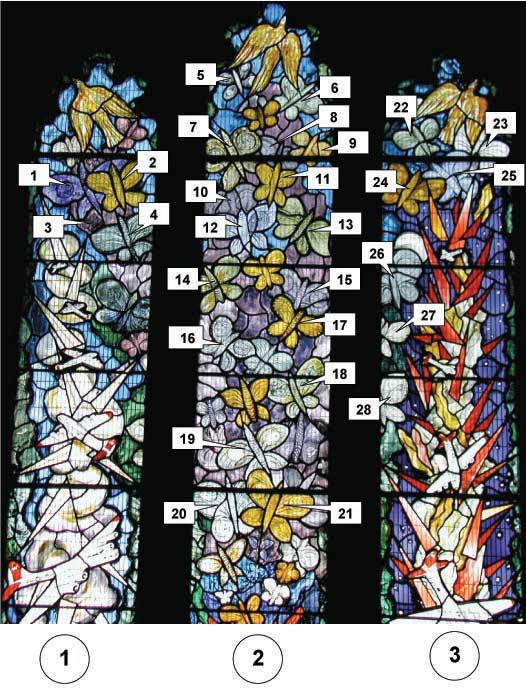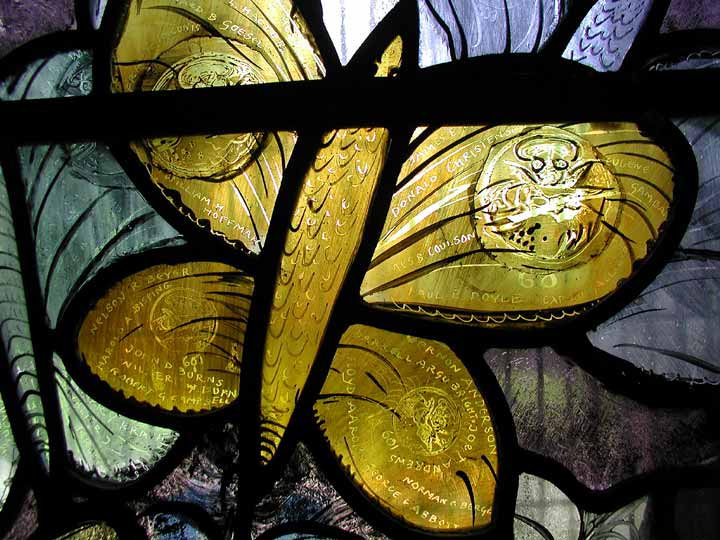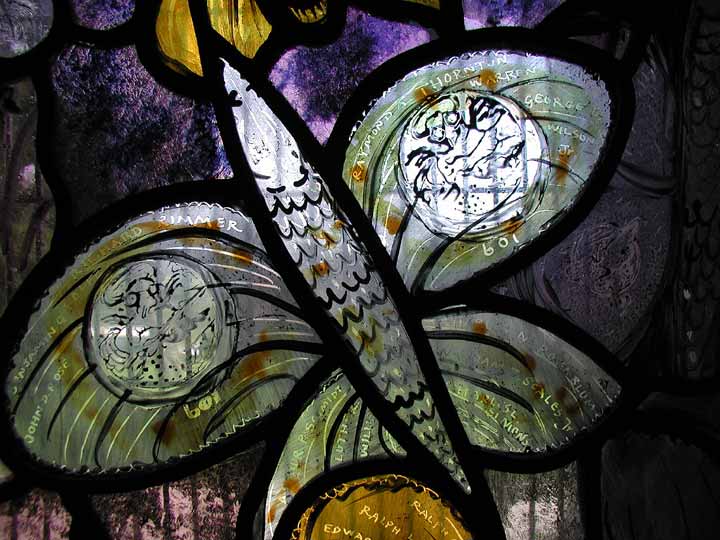398th Bomber Group Memorial Stained Glass Window
Details:
Viewed from the outside, the 398th Memorial Window is at the right of the entrance door that the congregation is approaching.
Commemorative Object
The stained glass windows remember the serve of the 398th Bomber Group which was stationed in nearby Nuthampstead; the Church is located a few miles, just over the hill, from the old 398th airbase.
The 398th Bomber Group consisted of the following squadrons:
600th Bombardment Squadron (N8)
601st Bombardment Squadron (3O)
602d Bombardment Squadron (K8)
603d Bombardment Squadron (N7)
The window consists of three panels. The center panel consists of butterflies, which are symbols of flight and transformation of the soul after death. Some of the butterflies are imprinted with the insignia of the four Squadrons of the 398th Group. The names of the 291 fallen are etched into the stained glass around their individual squadron insignia. At the bottom of the panel is the engulfment of Pharaoh's armies when the Red Sea closed over them, intended to show the defeat of an enemy in the face of all odds.
The left panel depicts the Old Testament Exodus Pillar of Smoke which led the Israelites by day, while the right panel depicts the Pillar of Fire which led them by night. In both panels, the B17 Flying Fortresses of the 398th Group are to be seen.
The artist for the creation of the memorial window was Patrick Reyntiens who was born in 1925 and educated at Ampleforth and the Edinburg College of Art. The Artist felt that because not all those who lost their lives were Christian, which suggested iconography that was not solely Christian. The artist turned primarily to the Old Testament rather than the new for his inspiration and in particular the Journey of the Israelites out of Egypt. The window was dedicated on June 11, 2000, and below it, is a printed paper containing more information about the memorial.
See site Nuthampstead for the 398th Bomber Group Memorial.
Source of information:
https://www.398th.org
Imperial War Museum War Memorials Register, www.waymarking.com
Source of photos:
Imperial War Museum War Memorials Register, www.warmemorialsonline.org.uk
https://www.398th.org
Monument Text:
On the paper:
THE WINDOW
The artist's basic considerations were (a) that, 50 years on, what we are above all commemorating is the defeat of an evil enemy in the face of enormous odds, and the sacrifice of the lives of 291 men who lived for a while among us here in North East Hertfordshire; (b) that not all those who lost their lives were necessarily Christian. These thoughts suggested an iconography that was not solely Christian.
The artist, in consequence, turned primarily to the Old Testament rather than the new for his inspiration, and in particular the Journey of the Israelites out of Egypt. At the bottom of the centre light is an evocation, or reminder, of the engulfment of Pharaoh's armies when the Red Sea closed back over them — an archetypal image of the defeat of an enemy in the face of odds.
The rest of the centre light is taken up with an ever expanding, moving mass of butterflies. These are not naturalistically coloured. The butterfly was, and is, a symbol of the flight and transformation of the soul after death; pagan symbolism, which was adopted and adapted by Byzantine Christianity. In the West, the emergence of the butterfly from the chrysalis has been used in many variations as the image of our release from worm-like existence here on earth and transformation after death.
The wings of the butterflies are imprinted with the badges of the four squadrons, as well as the names of those who lost their lives while serving at Station 131. The squadron badges are cartoonlike, and at first glance it might seem difficult to mix such earthly and secular images with the exalted concepts of the previous paragraph. But mediaeval craftsmen constantly achieved something similar with the admixture of gargoyles and the like with sublime architecture. Mr. Reyntiens is thus reverting to an earlier and hallowed tradition, to tie the memorial firmly and visibly to the actual people and institutions that inspire it and are commemorated in it.
Most of the butterflies are silvery white, in contrast to the dramatic reds, blues and greens at the bottom of the Red Sea. But a selection has wings stained golden yellow. The distribution of these golden winged butterflies up and across all three lights can be seen as a relatively unobtrusive, but nonetheless real, representation of the Cross, emerging quite naturally from the rising cloud of butterflies.
The left hand and right hand lights are filled with, respectively, the Pillar of Cloud, which led the Israelites by day, and the Pillar of Fire, which led them by night. Against the towering mass of cumulo-nimbus cloud on the left (with which the airmen of the 398th would have been all too familiar) are depicted a climbing stream of Flying Fortress (B17) Bombers. The 398th operated by day, and this panel provides a moving evocation of their daily ritual. The aircraft are seen in the right hand panel descending out of the pillar of fire as night falls, a vivid reminder of the chaos and violence out of which those who survived emerged. Incidentally, the aircraft depicted at the bottom of each light did survive the war Only 7 out of hundreds of aircraft survived the full year of operations. One was nicknamed "Maxine" and flew 81 missions with many different crews. This detail and the writing on the butterfly wings of the name of each individual who died while serving at Station 131 gives this window its unique quality of not being an anonymous and generalised commemoration.
How to Locate a Name on the Anstey Window Memorial
The Anstey Window Memorial consists of three stained glass panels labeled 1 (left), 2 (center), and 3 (right). Each panel features numbered butterflies (1–28), with names of fallen airmen etched into their wings. Each butterfly wing is divided into four sections:
A = Top Left
B = Top Right
C = Bottom Left
D = Bottom Right
To find a name, use the format: [Panel Number], [Butterfly Number], [Wing Section].
Example: "2, 21, D" means Panel 2 (center), Butterfly 21, Bottom Right Wing.
Commemorates:
People:
Units:
398th Bomber Group
398th Bomber Group, 601st Bomber Squadron
601st Bomber Squadron, 398th Bomb Group, Heavy
602nd Bomber Squadron, 398th Bomb Group
603rd Bomber Squadron, 398th Bomb Group
604th Bomber Squadron, 399th Bomber Group, Heavy
8th Air Force
US Army Air Corps
Wars:
WWII
Other images :

